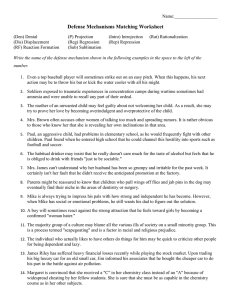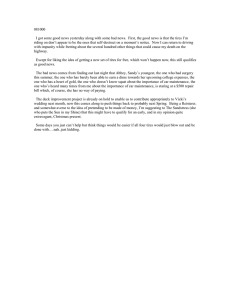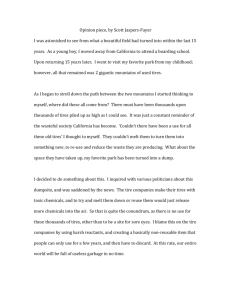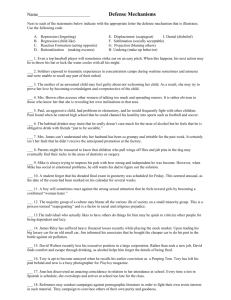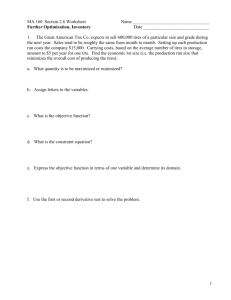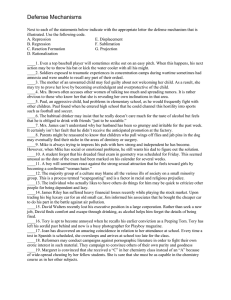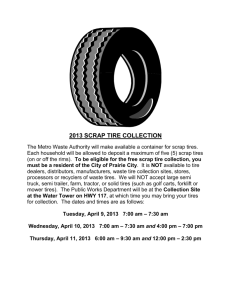Bar-Bar-A Horse and Cattle Drinker
advertisement
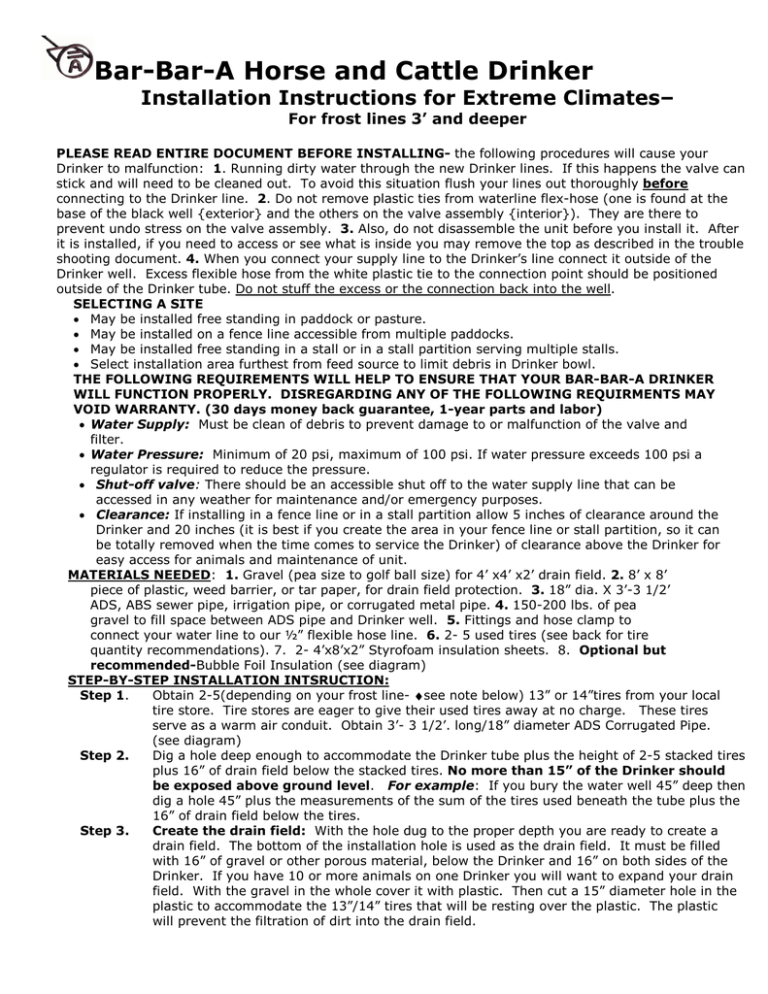
Bar-Bar-A Horse and Cattle Drinker
Installation Instructions for Extreme Climates–
For frost lines 3’ and deeper
PLEASE READ ENTIRE DOCUMENT BEFORE INSTALLING- the following procedures will cause your
Drinker to malfunction: 1. Running dirty water through the new Drinker lines. If this happens the valve can
stick and will need to be cleaned out. To avoid this situation flush your lines out thoroughly before
connecting to the Drinker line. 2. Do not remove plastic ties from waterline flex-hose (one is found at the
base of the black well {exterior} and the others on the valve assembly {interior}). They are there to
prevent undo stress on the valve assembly. 3. Also, do not disassemble the unit before you install it. After
it is installed, if you need to access or see what is inside you may remove the top as described in the trouble
shooting document. 4. When you connect your supply line to the Drinker’s line connect it outside of the
Drinker well. Excess flexible hose from the white plastic tie to the connection point should be positioned
outside of the Drinker tube. Do not stuff the excess or the connection back into the well.
SELECTING A SITE
• May be installed free standing in paddock or pasture.
• May be installed on a fence line accessible from multiple paddocks.
• May be installed free standing in a stall or in a stall partition serving multiple stalls.
• Select installation area furthest from feed source to limit debris in Drinker bowl.
THE FOLLOWING REQUIREMENTS WILL HELP TO ENSURE THAT YOUR BAR-BAR-A DRINKER
WILL FUNCTION PROPERLY. DISREGARDING ANY OF THE FOLLOWING REQUIRMENTS MAY
VOID WARRANTY. (30 days money back guarantee, 1-year parts and labor)
• Water Supply: Must be clean of debris to prevent damage to or malfunction of the valve and
filter.
• Water Pressure: Minimum of 20 psi, maximum of 100 psi. If water pressure exceeds 100 psi a
regulator is required to reduce the pressure.
• Shut-off valve: There should be an accessible shut off to the water supply line that can be
accessed in any weather for maintenance and/or emergency purposes.
• Clearance: If installing in a fence line or in a stall partition allow 5 inches of clearance around the
Drinker and 20 inches (it is best if you create the area in your fence line or stall partition, so it can
be totally removed when the time comes to service the Drinker) of clearance above the Drinker for
easy access for animals and maintenance of unit.
MATERIALS NEEDED: 1. Gravel (pea size to golf ball size) for 4’ x4’ x2’ drain field. 2. 8’ x 8’
piece of plastic, weed barrier, or tar paper, for drain field protection. 3. 18” dia. X 3’-3 1/2’
ADS, ABS sewer pipe, irrigation pipe, or corrugated metal pipe. 4. 150-200 lbs. of pea
gravel to fill space between ADS pipe and Drinker well. 5. Fittings and hose clamp to
connect your water line to our ½” flexible hose line. 6. 2- 5 used tires (see back for tire
quantity recommendations). 7. 2- 4’x8’x2” Styrofoam insulation sheets. 8. Optional but
recommended-Bubble Foil Insulation (see diagram)
STEP-BY-STEP INSTALLATION INTSRUCTION:
Step 1.
Obtain 2-5(depending on your frost line- ♦ see note below) 13” or 14”tires from your local
tire store. Tire stores are eager to give their used tires away at no charge. These tires
serve as a warm air conduit. Obtain 3’- 3 1/2’. long/18” diameter ADS Corrugated Pipe.
(see diagram)
Step 2.
Dig a hole deep enough to accommodate the Drinker tube plus the height of 2-5 stacked tires
plus 16” of drain field below the stacked tires. No more than 15” of the Drinker should
be exposed above ground level. For example: If you bury the water well 45” deep then
dig a hole 45” plus the measurements of the sum of the tires used beneath the tube plus the
16” of drain field below the tires.
Step 3.
Create the drain field: With the hole dug to the proper depth you are ready to create a
drain field. The bottom of the installation hole is used as the drain field. It must be filled
with 16” of gravel or other porous material, below the Drinker and 16” on both sides of the
Drinker. If you have 10 or more animals on one Drinker you will want to expand your drain
field. With the gravel in the whole cover it with plastic. Then cut a 15” diameter hole in the
plastic to accommodate the 13”/14” tires that will be resting over the plastic. The plastic
will prevent the filtration of dirt into the drain field.
Step 4.
Step 5.
Step 6.
Step 7.
With the drain field completed place 1 of the 13”/14” tires into the bottom of the hole, over
the 15” diameter hole cut in the plastic. Place the second 13”/14” tire on top of the first tire
an so forth completing your total amount of tires stacked. Run the source waterline through
the bottom tire(or between the tires that meets the level of your line) toward the top of the
hole. To prevent undue stress on the line between tires you may insert your line into a pipe
or drill a hole through the side of one of the 13”/14” tires.
Place the Drinker into the hole and rest it upon the 13”/14” tires. Find the end of the
waterline inside the bottom of the Drinker. Flush your supply line clean first (failing to
flush your line may result in dirt entering the valve and causing the valve to malfunction)
and then connect the supply line with the Drinker line. Make the necessary connections to
the Drinker’s 1/2 “ flex horse using a barbed end fitting for the Drinker line with a male
threaded end that will fit into your supply line fitting. Use hose clamps and Teflon tape
around the connections used to ensure a leak-free fit. Keep the portion of the hose that
comes out of the Drinker on the exterior of the unit. Do not stuff up into the Drinker.
After connections have been made turn the water on and check for any leaks. With no
leaks, start adding fill dirt to the bottom of the 13”/14” tires and tamp firm. Keep filling
until you get to the base of the Drinker tube. Check that the Drinker is slightly off level so
that when the basin is filled it overflows toward the end of the paddle and not toward the
slice that the paddle fits into the Drinker. This precaution helps keep the flow of water from
entering the inside of the unit. Continue filling and tamping the dirt.
With the Drinker in place over the tires, cover the top tire with a few inches of dirt. Place
the 3 ½ foot ADS pipe over the Drinker well resting on the dirt covering the tires. When
installation is completed the ADS pipe should be at least flush with the ground or slightly
above. You may need to vary the dirt amount covering the tire to make this adjustment.
Add more dirt around the ADS Pipe until the 20” mark is reached from the ground surface.
Add the pea gravel to the inside of the ADS pipe until the surface level is reached. As
shown in the diagram, add the Styrofoam insulation. Notch a 18” half circle out of the
inside middle of each piece and slide around the ADS Pipe. When in place continued filling
in the area with dirt tamping as you go. After filling the hole, if desired, you may add a 17”
tire on the surface as a protection to the unit from pawing.
TESTING THE UNIT AFTER INSTALLAION:
After the unit is installed it needs to be tested to be sure all is working properly. 1. Hold down the paddle
and fill the basin with water. Let the water drain. Drain time should be between 60 and 90 seconds (If
drain time is over 90 seconds then clean the filter as described in the maintenance section). 2. With this
test done remove the screws out of the top of the unit as described in the maintenance section and pull
the top and inner workings of the unit out of the ground. If the unit will not pull-up then the tube casing
has been concaved. This problem can be fixed by digging down to the problem area and reshaping the
tube. Before back filling again re-try to pull the unit out. When it comes out re-insert the workings and
top back into the unit. Align the screw holes and attach the screws and backfill carefully. Your unit is now
ready for use.
♦ Recommended tire (13” or 14”) amounts for usage below the base of the drinker:
For frost lines
3 ft. to 4 ft. – 2 tires.
4 ft. to 5 ft. – 3 tires
Over 5 ft. - 5 tires or 1 tire per frost line foot
Get to Know Your Unit
Learn how to maintain your own unit. The best time to do this is in pleasant weather and under controlled
circumstances. If a problem occurs you will be many times ahead of solving the problem. (See the trouble
shooting guide)
Check the Unit on a Regular Basis
Check your unit regularly to make sure water is coming into bowl and that drainage is speedy. If water is
not coming into the bowl animals will not have the water they need. If drainage is too slow the unit may
freeze. (See trouble shooting guide)
